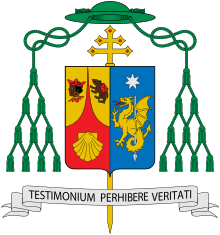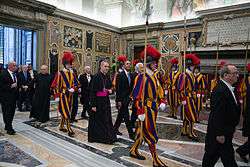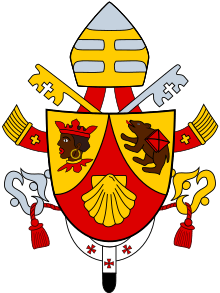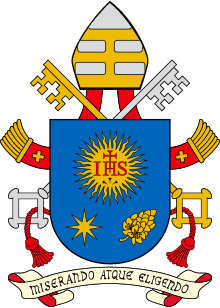Georg Gänswein
| The Most Reverend Georg Gänswein | |
|---|---|
| Prefect of the Papal Household | |
|
Archbishop Gänswein in 2013 | |
| See | Urbs Salvia (titular) |
| Appointed | 7 December 2012 |
| Installed | 6 January 2013 |
| Predecessor | James Michael Harvey |
| Other posts |
|
| Orders | |
| Ordination |
31 May 1984 by Archbishop Oskar Saier |
| Consecration |
6 January 2013 by Pope Benedict XVI |
| Rank | Archbishop |
| Personal details | |
| Birth name | Georg Gänswein |
| Born |
30 July 1956 Riedern am Wald, Waldshut, Germany |
| Nationality | German |
| Denomination | Roman Catholic |
| Residence | Vatican City State |
| Occupation | |
| Alma mater | Ludwig Maximilians University of Munich |
| Motto | Testimonium perhibere veritati (Give testimony to the Truth) - John 18:37 |
| Coat of arms |
 |
| Styles of Georg Gänswein | |
|---|---|
 | |
| Reference style | The Most Reverend |
| Spoken style | Your Excellency |
| Religious style | Archbishop |
| Ordination history of Georg Gänswein | |
|---|---|
Diaconal ordination | |
| Date of ordination | 19 December 1982 |
Priestly ordination | |
| Ordained by | Oskar Saier (Freiburg) |
| Date of ordination | 31 May 1984 |
Episcopal consecration | |
| Principal consecrator | Pope Benedict XVI |
| Co-consecrators |
Tarcisio Card. Bertone SDB (Card. Sec. of State) Zenon Card. Grocholewski (Pref. Cong. Inst. Cath.) |
| Date of consecration | 6 January 2013 |
| Place of consecration | Saint Peter's Basilica |
Georg Gänswein /ˈɡɛ:ɒək ˈɡɛ:ŋ̩zvəin/ (Non-rhotic pronunciation)or /ˈɡɛ:ɔrk ˈɡɛ:ŋ̩zvəin/ (Rhotic pronunciation) (born 30 July 1956) is a German Archbishop of the Catholic Church, Chaplain of His Holiness,[1] Prefect of the Papal Household and the personal secretary of the Pope Emeritus Benedict XVI.
Archbishop Gänswein is fluent in both speaking and writing Italian, Spanish, German and Latin.[2]
Life
Gänswein was born in Riedern am Wald, Waldshut, Baden-Württemberg, a village in the Black Forest and part of Ühlingen-Birkendorf municipality in Germany, as the eldest son of Albert Gänswein, a blacksmith, and his wife Gertrud. He has two brothers and two sisters.[3]
Gänswein has said that he decided to become a priest in 1974 when he was 18. In 1976 at the age of 20 he began his seminary training for the Archdiocese of Freiburg, for which he was ordained on 31 May 1984 at 28.[4] The claim that he attended the International Seminary of Saint Pius X in Switzerland[5] has been denied by Gänswein.[6]
Upon his ordination, Gänswein dedicated himself to rigorous academic activities. He received his J.C.D. degree from Ludwig Maximilians University of Munich in 1993. In an interview, Gänswein describes the two years he spent in the Black Forest as a curate (assistant priest) after his ordination to the priesthood. In 1993, he wrote his dissertation in Munich about Ecclesiology according to the Second Vatican Council. He notes that, "After half a year I was so fed up I said to myself, now I'm going to the archbishop and ask him to take me back into the diocese because I can't stand it anymore," adding later in the interview, "I'd always studied gladly and easily, but studying Canon Law I felt to be as dry as work in a quarry where there's no beer — you die of dryness."[7]
In January 2007, Italian artist and fashion designer Donatella Versace used Gänswein as the artistic inspiration for her Fall 2007 "Clergyman Collection", thereby boosting popular recognition of Gänswein's nickname, "Gorgeous George" (Italian: Bel Giorgio).[8] In January 2013, Gänswein, without his consent or that of the Holy See, appeared on the cover of the Italian version of Vanity Fair magazine.[9]
Roman Curia
Gänswein arrived in Rome in 1995 as an official of the Congregation for Divine Worship and the Discipline of the Sacraments. In 1996 he was invited by Cardinal Joseph Ratzinger to join the Congregation for the Doctrine of the Faith. After being appointed to Cardinal Ratzinger's staff, Gänswein became professor of canon law at the Pontifical University of the Holy Cross.
In 2000, Gänswein was elevated by Pope John Paul II to Chaplain of His Holiness. He replaced Josef Clemens as Ratzinger's personal secretary in 2003, upon Clemens's appointment as secretary of the Pontifical Council for the Laity. Ratzinger was elected to the papacy in 2005 and Gänswein was appointed to the office of Principal Private Secretary to His Holiness. A year later Pope Benedict XVI honoured his secretary with the distinction Prelate of His Holiness.
It was suggested that Gänswein was to replace the aging Cardinal Friedrich Wetter as the new Archbishop of Munich and Freising. However, Pope Benedict XVI appointed Cardinal Reinhard Marx as the new archbishop of the archdiocese in November 2007.
In his private life, Gänswein devotes his time to playing tennis, skiing, and flying airplanes. In an interview in July 2006, he described the Pope's typical day: "The Pope's day begins with Mass at 7am, followed by morning prayer and a period of contemplation. Afterwards we eat breakfast together, and my day then begins with sorting through the correspondence, which arrives in considerable quantity." He said that he accompanied Benedict to morning audiences, followed by lunch together, a "short walk," and a rest, after which he "[presents] to the Pope documents which require his signature, or his study and approval."[10]
Prefect of the Pontifical Household
On 7 December 2012, Gänswein was appointed Titular Archbishop of Urbs Salvia and at the same time prefect of the Pontifical Household, replacing Cardinal James Michael Harvey.[11]
He was consecrated bishop on 6 January 2013 along with Angelo Vincenzo Zani, Nicolas Thevenin and Fortunatus Nwachukwu by Pope Benedict. It is the job of Archbishop Gänswein to arrange papal audiences both public and private, regardless of their size or rank of visitors – as well as handling the logistics for most large Vatican events and ceremonies as well as the pope's travels both in Rome and all of Italy. On 12 January 2013 Archbishop Gänswein welcomed Albert II, Prince of Monaco and his wife. This is the first time that he welcomed the head of a foreign state since his appointment as prefect and his consecration.
Indication of resignation of Benedict XVI
Paul Collins, a well connected commentator on Benedict XVI, has suggested[12] that the elevation of the Pope's personal assistant to Archbishop in early December 2012 (he was consecrated as Bishop on 6 January 2013) was an indication of the impending resignation of Benedict XVI. Such elevations of the Pope's personal secretary have previously normally occurred only shortly before the death of a Pope, but while the Pope was still lucid.
It was announced that Gänswein would move with the retired Pope to Castel Gandolfo on 28 February 2013 while retaining his role as head of the Pontifical Household. “The Pope will be accompanied to Castel Gandolfo and also to the monastery by Archbishop Gänswein and the Memores Domini, because this is the fundamental nuclear group of the pontifical family ... He will also remain the head of the Papal Household”, Vatican spokesman Father Federico Lombardi told the press on 14 February.[13]
The dual role of Gänswein would seem to bolster concerns expressed privately by some cardinals that Benedict would continue to exert at least some influence. Asked about this apparent conflict of interest, Federico Lombardi SJ said the prefect's job was very technical and involved organising the Pope's audiences. ″In this sense it is not a very profound problem″ he said.[14]
Benedict XVI resignation

Asked in an interview in the German weekly Bunte whether then Pope Benedict had talked to him about his intention to resign, Archbishop Gänswein said he had known about the Pope's intention for "quite some time beforehand" and had tried to change his mind, but failed. "Pope Benedict had reached a decision. He was not to be shaken", he said.[15]
Archbishop Gänswein described the news of the Pope Emeritus’ resignation in February as “an amputation”. Gänswein, who was by Benedict XVI’s side for the duration of his eight-year papacy, said “I gave blood for eight years,” the German weekly Die Zeit reported. Pope Francis asked him to remain in office and Gänswein replied, “If that is your wish, then I obediently accept it.” “I must be honest with myself: Accepting and coming to terms with my new role is painful,” he later stated. Die Zeit said that Gänswein saw Pope Francis’ decision to live in the Domus Sancta Marthae guesthouse and not the papal apartments as an affront against his predecessor.
“Benedict didn’t live in the papal apartments for egotistical reasons – he was also very modest”, Gänswein said. The German weekly suggested that a certain uneasiness exists in Gänswein’s relationship with Pope Francis. “At the beginning of each day, I find myself once again waiting to see what will be different today.” The paper said that each evening after 9 pm Gänswein looks after the former Pope’s affairs and deals with his post for the man he still calls “Holy Father”.[16]
In an interview in 2014 to mark the first anniversary of the resignation of Pope Benedict XVI Archbishop Ganswein said that "I am certain, indeed convinced, that history will offer a judgment that will be different than what one often read in the last years of his pontificate because the sources are clear and clarity springs from them."[17]
In 2016 speech reflecting on Pope Benedict XVI’s pontificate, Archbishop Gänswein has confirmed the existence of a group who fought against Benedict’s election in 2005, but stressed that "Vatileaks" or other issues had "little or nothing" to do with his resignation in 2013. Speaking at the presentation of a new book on Benedict’s pontificate at the Pontifical Gregorian University in Rome May 20, Archbishop Gänswein also said that Pope Francis and Benedict are not two popes “in competition” with one another, but represent one “expanded” Petrine Office with “an active member” and a “contemplative.” Archbishop Gänswein said Benedict did not abandon the papacy like Pope Celestine V in the 13th century but rather sought to continue his Petrine Office in a more appropriate way given his frailty. “Therefore, from 11 February 2013, the papal ministry is not the same as before,” he said. “It is and remains the foundation of the Catholic Church; and yet it is a foundation that Benedict XVI has profoundly and lastingly transformed by his exceptional pontificate.”[18]
Relationship with Pope Francis

In March 2014 he said he was shocked by the election of Pope Francis. Asked on ZDF on 13 March whether the election of Pope Francis at the conclave last year had surprised him, Archbishop Gänswein said, “Well, yes, as I had favoured other candidates –I was wrong – but then so were other people.” He went on to say that at the moment the Pope is the darling of the media “but that won’t always be the case”. The Pope is not “everybody’s darling”, he said.[19]
2014 Extraordinary General Synod
Archbishop Gänswein said that marriage cannot be dissolved and that "starting a new union contradicts what the Lord has indicated". He made the remarks in an interview with Chi magazine, excerpts of which were released in advance on the fringes of a synod of bishops on the family that opened Monday in the Vatican. Asked about the question of possibly allowing divorced people to take communion, Gaenswein said "this is a very delicate question, at stake is the sacramental matrimony that according to Catholic doctrine cannot be dissolved, just like the love of God for man" "As far as I can see Pope Francis is following the line of his predecessors whose teaching on matrimony is very clear".[20]
Role of Pope emeritus
Archbishop Ganswein has denied the Pope emeritus Benedict XVI played a behind-the-scenes role over the issue of Communion for divorced and civilly remarried Catholics, calling such reports a “pure invention.” During the Extra Ordinary Synod of Bishops on the Family, there were persistent rumours that a delegation of conservative cardinals who were worried about a possible change for the divorced and remarried sought out Benedict’s counsel. Gänswein said that meeting never happened. “A supposed intervention by the Pope emeritus [during the Synod of Bishops] is pure invention,” said Gänswein, who served as priest-secretary for the then-Cardinal Joseph Ratzinger at the Congregation for the Doctrine of the Faith and then became his closest aide as pope.[21]
Pontifical Urbaniana University address
Benedict XVI said dialogue with other religions is no substitute for spreading the Gospel to non-Christian cultures, and warned against relativistic ideas of religious truth as “lethal to faith.” He also said the true motivation for missionary work is not to increase the church’s size but to share the joy of knowing Christ. The retired pope’s words appeared in written remarks to faculty members and students at Rome’s Pontifical Urbaniana University. Archbishop Ganswein read the 1,800-word message aloud Oct. 21, at a ceremony dedicating the university’s renovated main lecture hall to the retired pope. The speech is one of a handful of public statements, including an interview and a published letter to a journalist, that Pope Benedict has made since he retired in February 2013.[22]
Curial reform
Archbishop Gänswein said: “I personally can see no significant reason which would necessitate a reform of the Curia at the moment. One or two changes have been made but that is part of the normal run of things. To speak of ‘Curial reform’ is, if I may so, somewhat of an exaggeration.” Gänswein, whose view of the status quo in the Vatican are probably supported by a not inconsiderable number of the hierarchy, according to insiders, was giving an interview to the German website katholisch.de. He was asked whether the Vatican and the Church in general are polarised at the moment. “There is no polarisation as far as I can see and I haven’t experienced any. Certain measures here and there have been criticised and if the criticism is justified, that can surely benefit the general climate,” he said.[23]
Honours
- Honorary Prelate by Papal Decree of Pope John paul II
- Bavarian Order of Merit
- Knight commander in the Order of the Star of Romania.
- Grand officer in the Order of Merit of the Italian Republic.
- Knight Grand cross in the Order of Merit of the Federal Republic of Germany.
- Decoration of Honour for Services to the Republic of Austria
Arms
On the sinister side of Archbishop Gänswein's chivalric coat of arms is the draconian serpent that heraldically symbolises the Devil being slain by his patron, Saint George – and, in this instance, has been viewed as a symbol of his duty to protect the Pope. The image is superimposed by a seven-point star representing the Blessed Virgin Mary. Gänswein has taken "Testimonium Perhibere Veritati" ("To bear witness to the truth") as his episcopal motto.
 |
|
References
- ↑ Within the Roman Catholic discipline, the title P.C. does not vanquish even upon clerical appointment, except in instances when it is absolved canonically by the Pope as Bishop of Rome.
- ↑ SSPX Seminary training in Écône, Switzerland includes a longterm proficiency course and examination on learning the Latin language, both as a written tool and a speaking normative.
- ↑ "Pope appoints Gäenswein Prefect of Pontifical Household and archbishop". Vatican Insider - La Stampa. 2012-12-07.
- ↑ Power behind the papal throne Profile of Archbishop-elect Georg Gänswein
- ↑ http://www.lexpress.fr/actualite/societe/vatican-les-clefs-d-une-crise_740209.html
- ↑ „Ich hatte nie und habe auch gegenwärtig keinerlei Kontakte mit Ecône oder mit Anhängern von Ecône. Wer das behauptet, will mir schlichtweg schaden.“ („I never had or have currently any contact with Ecône or its adherents. Whoever says that simply wants to damage me.“) - Georg Gänswein, in: Hanspeter Oschwald, Im Namen des Heiligen Vaters: Wie fundamentalistische Mächte den Vatikan steuern, München 2010
- ↑ http://www.catholicculture.org/culture/library/view.cfm?recnum=7715
- ↑ Moore, Malcolm (16 January 2007). "Gorgeous Georg's priestly chic inspires a new Versace show". The Daily Telegraph. London.
- ↑ "Gorgeous Georg: Pope's Private Secretary Becomes Vanity Fair Cover Boy". Time. 18 January 2013.
- ↑ Owen, Richard (2007-01-16). "Meet the inspiration for the latest Versace look - the Pope's secretary". London: The Times. Retrieved 2008-03-19.
- ↑ Archbishop Georg Gänswein
- ↑ Paul Collins on the implications of Pope Benedict's resignation, Paul Collins on ABC Radio National's "Religion and Ethics Report", Broadcast: Wednesday 13 February 2013 5:50PM
- ↑
- ↑ "Pope's aide to stay on with Benedict and serve successor". The Guardian. London. 14 February 2013.
- ↑
- ↑
- ↑ "Reuters Q&A with Archbishop Georg Gänswein in English and Italian". Reuters. 9 February 2014.
- ↑
- ↑
- ↑
- ↑ Benedict XVI aide denies rift with Francis
- ↑
- ↑ Reform of the Curia is unnecessary, says Archbishop Gänswein
External links
| Wikimedia Commons has media related to Georg Gänswein. |
| Catholic Church titles | ||
|---|---|---|
| Preceded by Stanisław Dziwisz |
Personal Papal Secretary 19 April 2005–28 February 2013 |
Succeeded by Alfred Xuereb |
| Preceded by Giuseppe Bertello |
— TITULAR — Archbishop of Urbs Salvia (pro hac vice) 7 December 2012–present |
Incumbent |
| Preceded by James Michael Harvey |
Prefect of the Pontifical Household 7 December 2012–present | |



